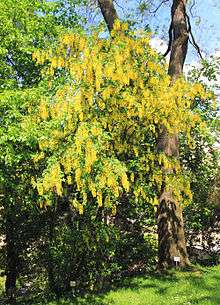Laburnum alpinum
Laburnum alpinum, the Scotch laburnum,[1] Scottish laburnum[2] or alpine laburnum, is a leguminous, (Leguminosae), deciduous tree.
| Laburnum alpinum | |
|---|---|
 | |
| Scientific classification | |
| Kingdom: | |
| (unranked): | |
| (unranked): | |
| (unranked): | |
| Order: | |
| Family: | |
| Subfamily: | |
| Tribe: | |
| Genus: | |
| Species: | L. alpinum |
| Binomial name | |
| Laburnum alpinum | |
Description
Laburnum alpinum is similar to Laburnum anagyroides,[3] it grows to 5 metres (16 ft) by 6 metres (20 ft), at a fast rate. It is hardy to zone 5.
It is in flower from May to June, and the seeds ripen from September to October. The panicles of vanilla scented, pea-like flowers are hermaphrodite (having both male and female organs) and are pollinated by insects.
The fruit is a pod or legume, the seeds green at first but becoming shiny black.[4]
The leaves are cholagogue and purgative. All parts of this plant are poisonous if consumed in large enough quantities[5] and should not be eaten or used internally.
Distribution
It is native to Central and Southern Europe and has naturalized in Scotland.[6] L. alpinium and L. anagyroides Medic. both are common as a garden escape in Northern Ireland.[7]
Cultivation
Laburnum alpinum is cultivated as an ornamental tree. Plants can be successfully transplanted even when quite large. The most common ornamental Laburnum plant is a hybrid of this species and Laburnum anagyroides, Laburnum × watereri.
The plant prefers well-drained, light (sandy), medium (loamy) soil but tolerates heavy clay and nutritionally poor soils. Preferring acid, neutral and basic (alkaline) soils, it can grow in semi-shade (light woodland) or full sun.
It can withstand strong winds but not maritime exposure and tolerates atmospheric pollution. The plant is notably susceptible to honey fungus.
Laburnum has a symbiotic relationship with certain soil bacteria, these bacteria form nodules on the roots and fix atmospheric nitrogen. Some of this nitrogen is utilized by the growing plant but some can also be used by other plants growing nearby.
References
- "Laburnum alpinum". Natural Resources Conservation Service PLANTS Database. USDA. Retrieved 22 January 2016.
- "BSBI List 2007". Botanical Society of Britain and Ireland. Archived from the original (xls) on 2015-01-25. Retrieved 2014-10-17.
- Webb, D.A., Parnell, J. and Doogue, D. 1996. An Irish Flora. Dundalgan Press Ltd. Dundalk. ISBN 0-85221-131-7
- Kilbracken, J. 1995. Easy way guide Trees Larousse ISBN 0-7523-0027-X
- Reader's Digest Encyclopedia of Garden Plants and Flowers. Ed and Designed by The Reader's Digest Association, London.1978.
- "Laburnum alpinum". Plants for a Future. Retrieved April 6, 2013.
- Hackney, P. (Ed) Stewart and Corry's Flora of the North-east of Ireland. Institute of Irish Studies , The Queen's University of Belfast. ISBN 0 85389 446 9 (HB)
| Wikimedia Commons has media related to Laburnum alpinum. |